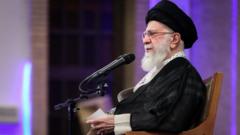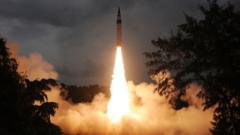In a recent announcement, experts warned that increased dangers from nuclear threats, climate change, and artificial intelligence misuse place humanity at 89 seconds to midnight.
Doomsday Clock Moves Closer to Midnight: A Warning for Humanity

Doomsday Clock Moves Closer to Midnight: A Warning for Humanity
The Bulletin of the Atomic Scientists has adjusted the iconic Doomsday Clock to reflect rising global risks.
The world teeters on the brink of catastrophe, according to the latest assessment by the Bulletin of the Atomic Scientists. In a press conference held on Tuesday, the organization revealed that the symbolic Doomsday Clock has moved closer to midnight, now standing at 89 seconds. This change reflects grave concerns about the escalating threats posed by nuclear weapons, climate change, and the potential misuse of artificial intelligence and biological science.
The adjustment serves as a stark reminder of the precarious state of global safety. The organization pointed out that misinformation and conspiracy theories amplify these threats, escalating the risk of global disaster. "A shift of even a single second should serve as a clarion call," the Bulletin stated, emphasizing that timely action is crucial to avert catastrophe.
The Doomsday Clock, established in 1947, has evolved in its focus from a sole concern about nuclear war — particularly between the United States and the Soviet Union — to a broader array of threats including climate change and pandemics. The hands of the clock have fluctuated over the years, with the most recent adjustment occurring in January 2023 amid the ongoing conflict in Ukraine.
Historically, the clock was last set farthest from midnight in 1991, coinciding with the Strategic Arms Reduction Treaty that sought to reduce long-range nuclear arsenals. At that time, the clock was positioned at 17 minutes to midnight, underscoring a brief period of relative global stability. Today, experts warn that the stakes are higher than ever and that immediate action is essential to change course.
The adjustment serves as a stark reminder of the precarious state of global safety. The organization pointed out that misinformation and conspiracy theories amplify these threats, escalating the risk of global disaster. "A shift of even a single second should serve as a clarion call," the Bulletin stated, emphasizing that timely action is crucial to avert catastrophe.
The Doomsday Clock, established in 1947, has evolved in its focus from a sole concern about nuclear war — particularly between the United States and the Soviet Union — to a broader array of threats including climate change and pandemics. The hands of the clock have fluctuated over the years, with the most recent adjustment occurring in January 2023 amid the ongoing conflict in Ukraine.
Historically, the clock was last set farthest from midnight in 1991, coinciding with the Strategic Arms Reduction Treaty that sought to reduce long-range nuclear arsenals. At that time, the clock was positioned at 17 minutes to midnight, underscoring a brief period of relative global stability. Today, experts warn that the stakes are higher than ever and that immediate action is essential to change course.




















